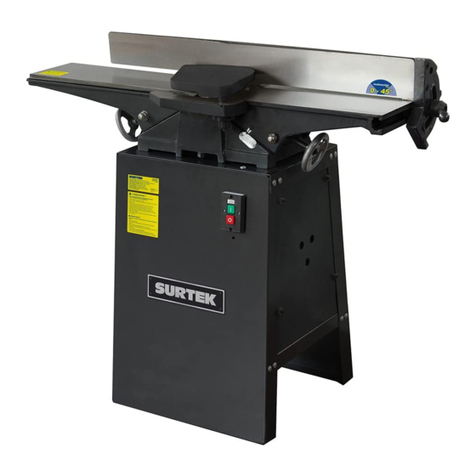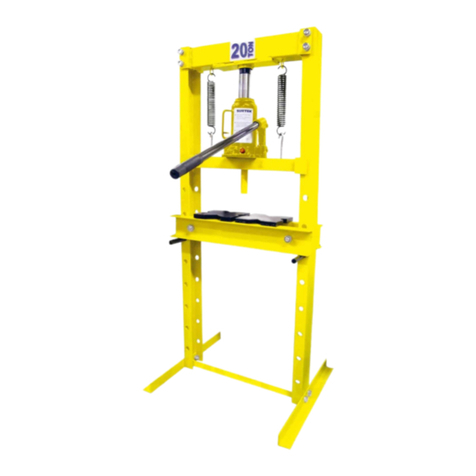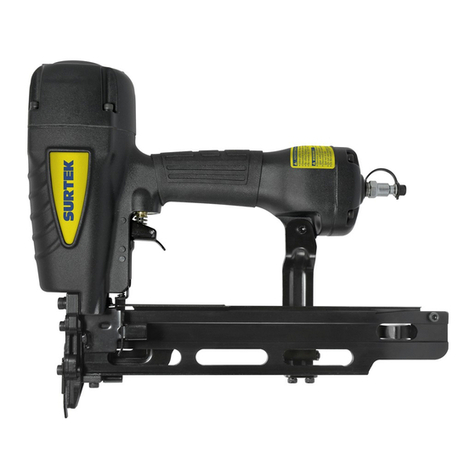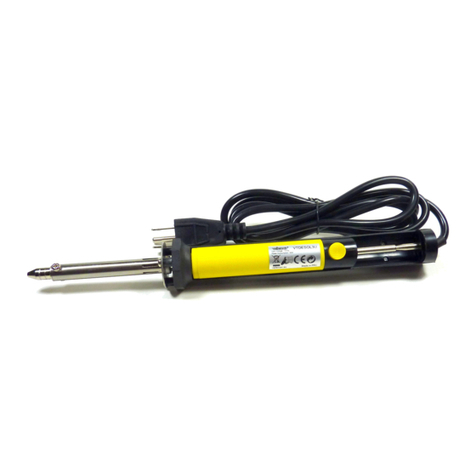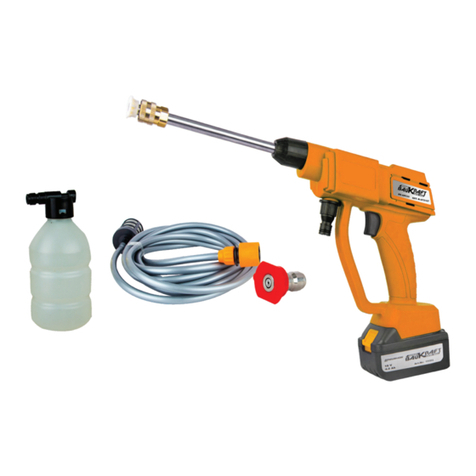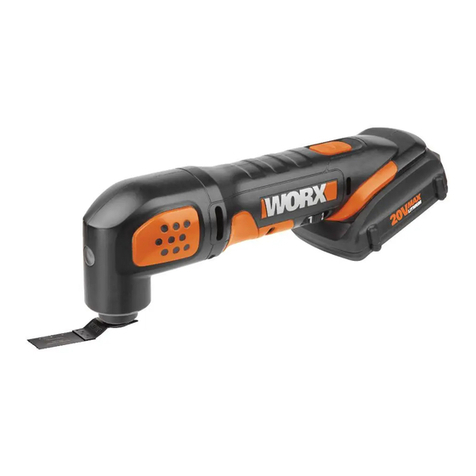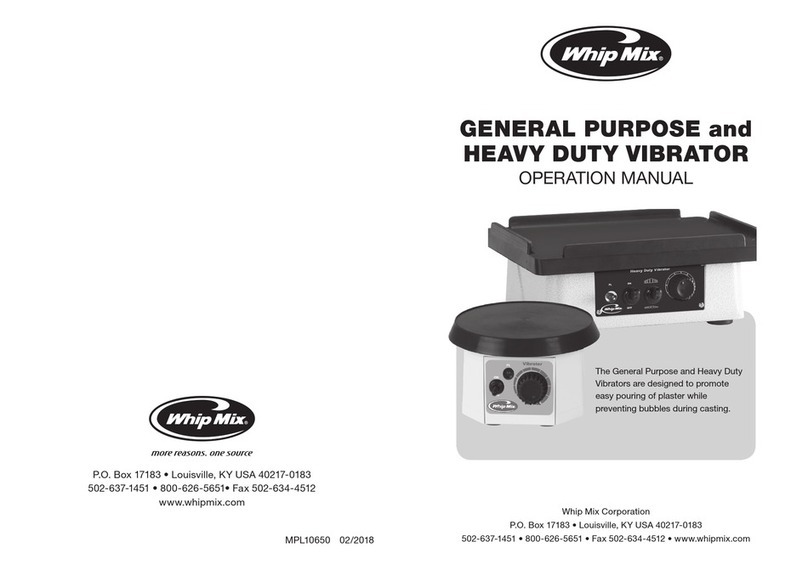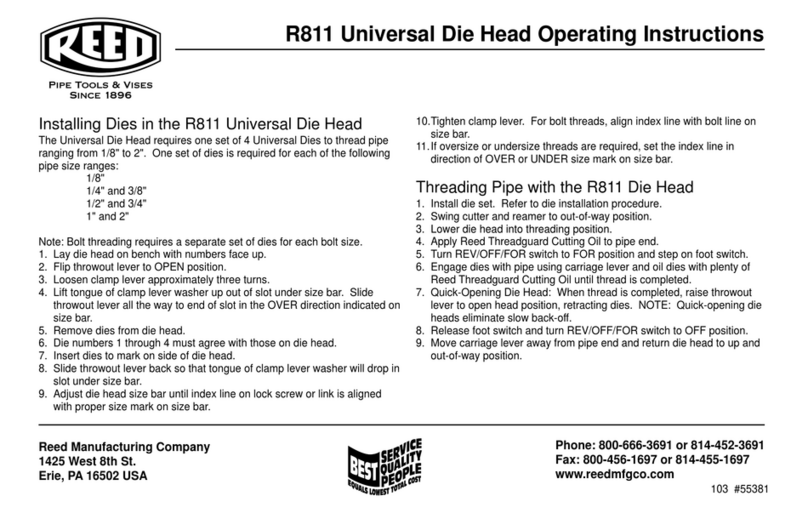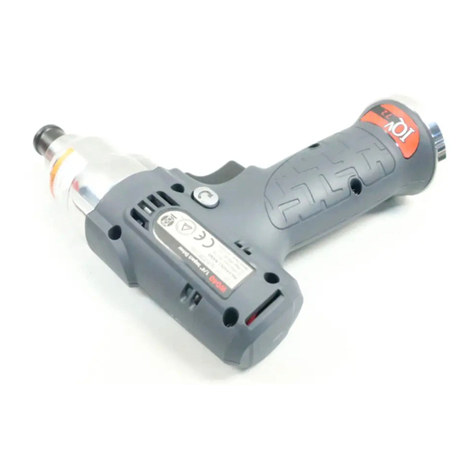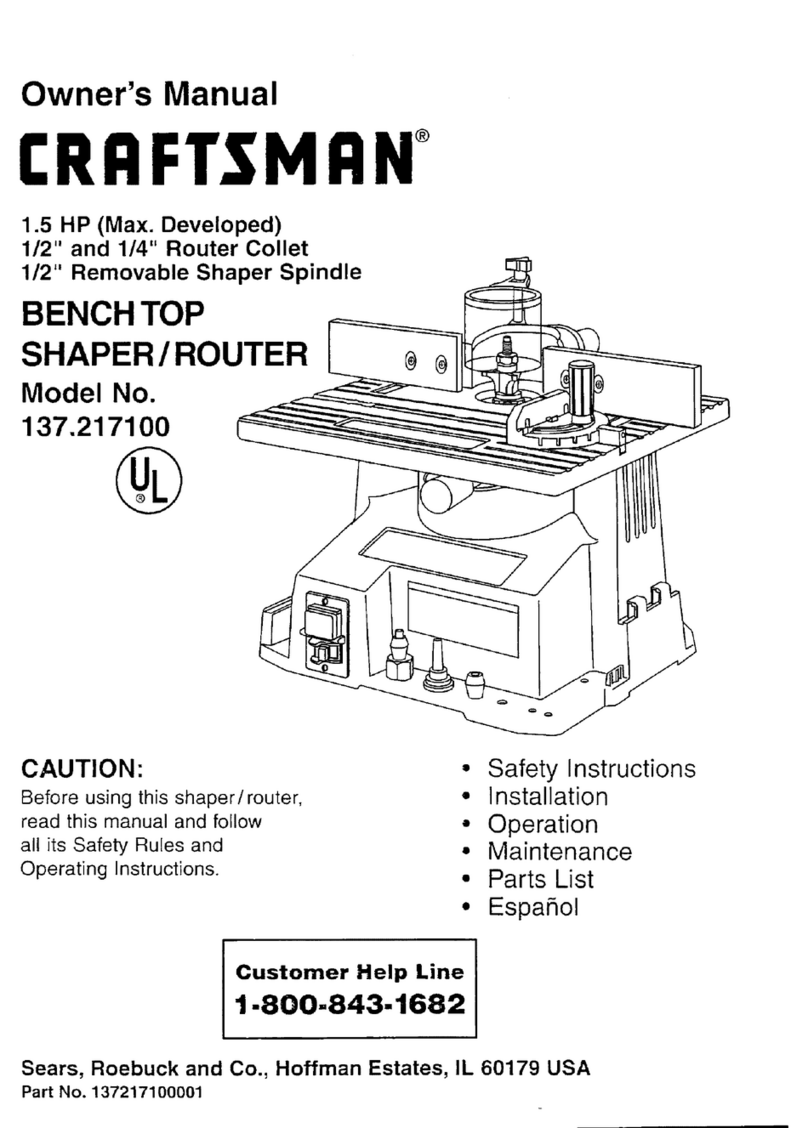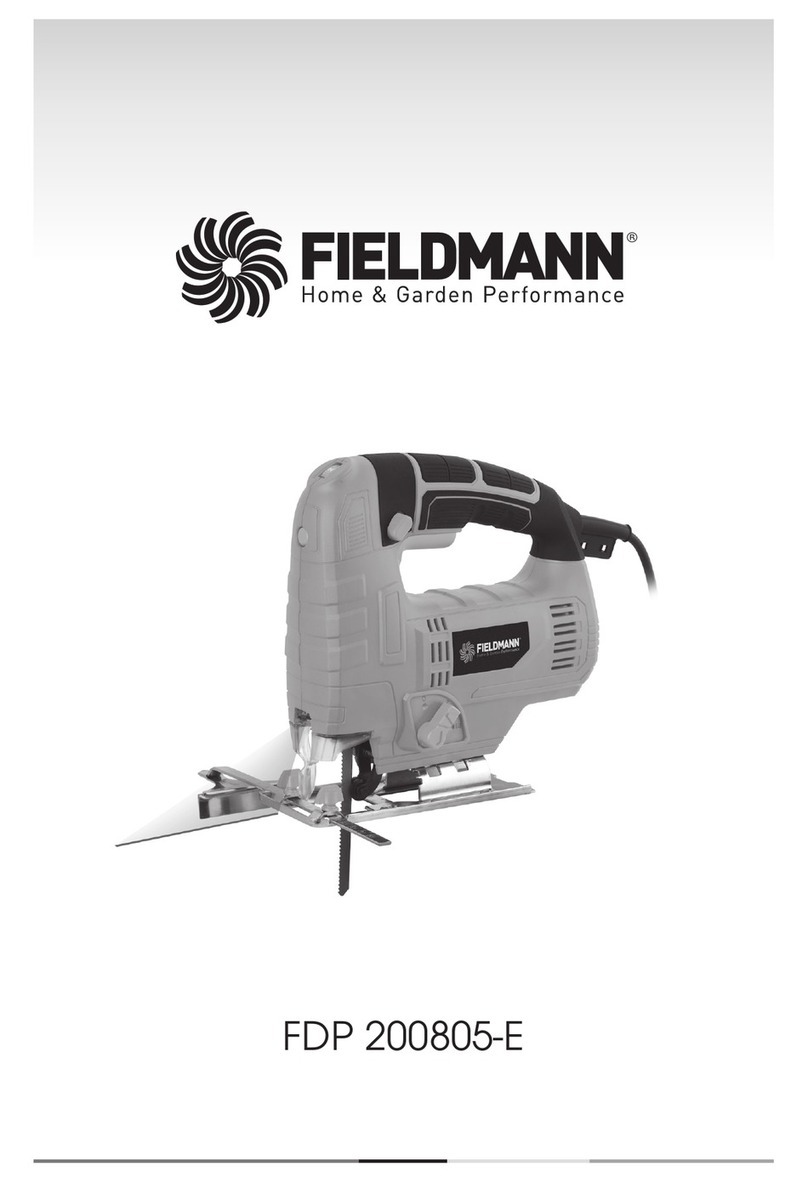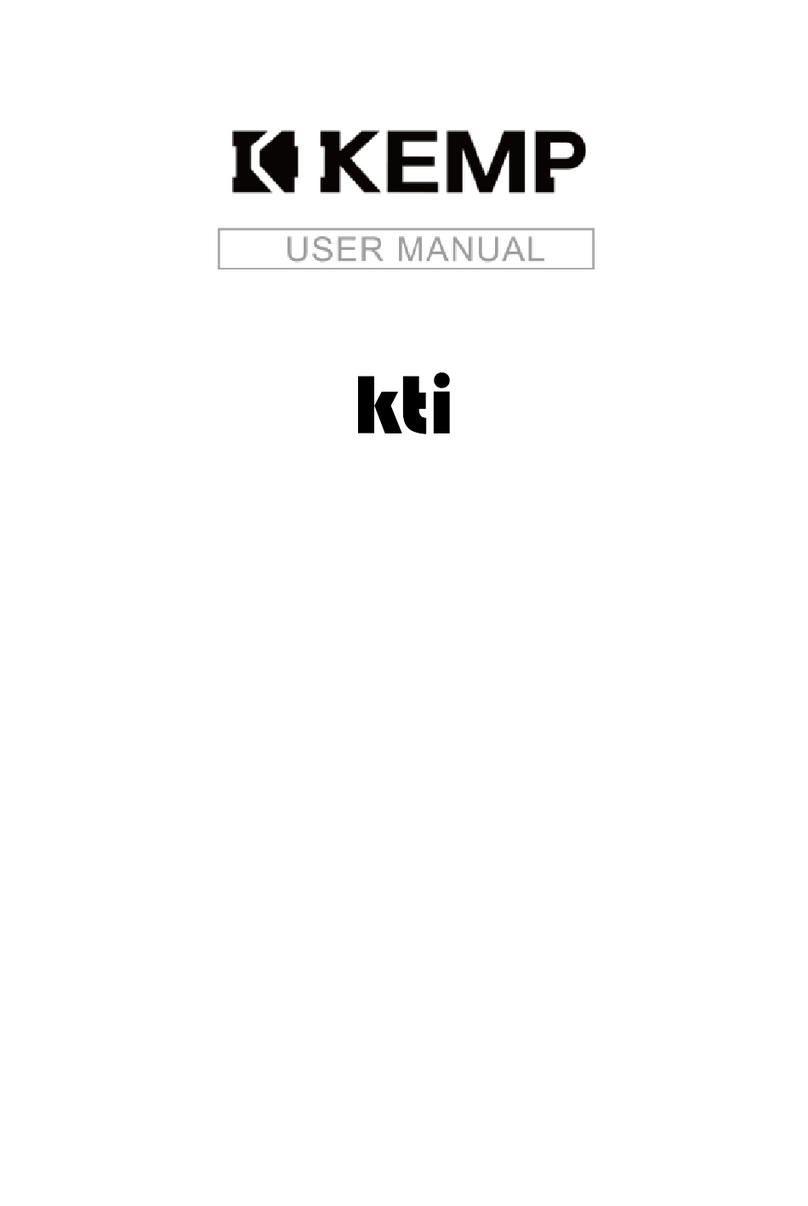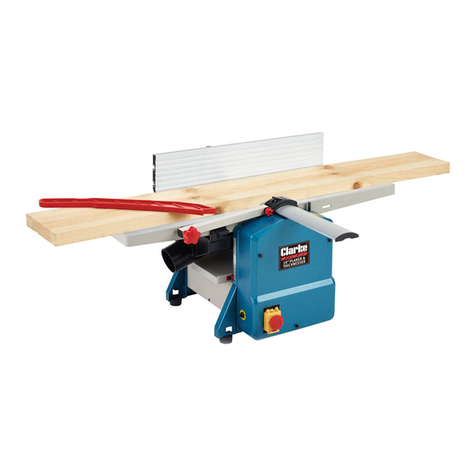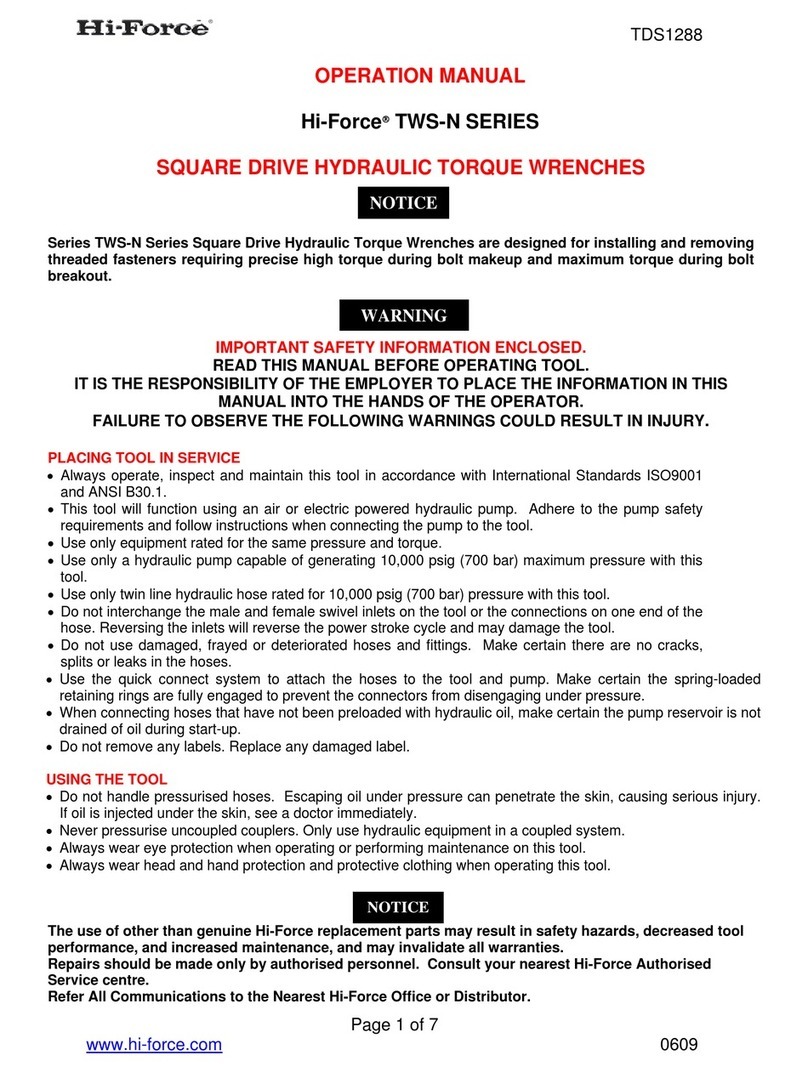Surtek MH600 User manual

ATENCIÓN: Lea, entienda y siga las instrucciones de seguridad contenidas en este
manual antes de operar esta herramienta.
WARNING: Read, understand and follow the safety rules in this manual, before operating this tool.
MH600
Herramienta Multipropósitos
Multi-Purpose Oscillating Tool
Manual de Usuario y Garantía.
User’s Manual and Warranty.
MH600 manual.indd 1 24/07/15 16:05

2
ENGLISHESPAÑOL
General safety rules
Electric safety
Personal safety
Tool use and care
Specific safety rules for
multipurpose oscillating tool
Features
Assembly & Operating
Maintenance
Technical data
Warranty policy
Normas generales de seguridad
Seguridad eléctrica
Seguridad personal
Utilización y cuidados de las
herramientas eléctricas
Advertencias de seguridad para
herramientas multipropositos
Características
Ensamble y Operación
Mantenimiento
Especificaciones técnicas
Garantía
10
10
10
11
11
12
12
15
15
16
3
3
3
4
5
5
7
9
9
16
CONTENIDO CONTENT
SÍMBOLOS SYMBOLS
PELIGRO, ADVERTENCIA, PRECAUCIÓN:
Indica un riesgo personal o la posibilidad
de un daño.
Herramientas tipo II: Doble aislamiento,
protege las herramientas eléctricas.
DANGER, CAUTION, WARNING: Indicates risk of
personal injury and/or the possibility of damage.
Type II power tools: Indicates double insulation.
MH600 manual.indd 2 24/07/15 16:05

ESPAÑOL•Manual de Usuario
3
NORMAS GENERALES DE SEGURIDAD
Esta herramienta tiene características que ha-
rán su trabajo más rápido y fácil. Seguridad, co-
modidad y confiabilidad fueron previstos como
prioridad para el diseño del mismo, haciendo
más fácil su operación.
ADVERTENCIA: Lea todas las advertencias
de seguridad y todas las instrucciones. La omi-
sión de alguna de las advertencias e instruccio-
nes que se enlistan a continuación puede dar
como resultado un choque eléctrico, fuego y/o
un daños serios.
CONSERVE TODAS LAS ADVERTENCIAS Y
TODAS LAS INSTRUCCIONES.
SEGURIDAD EN EL ÁREA DE TRABAJO
Mantenga el área de trabajo limpia y bien ilu-
minada. Las áreas desordenadas y oscuras pro-
vocan accidentes.
No maneje herramientas eléctricas en atmós-
feras explosivas, tales como en presencia de
líquidos inflamables, gases o polvo. Las herra-
mientas eléctricas crean chispas que pueden
encender el polvo o los humos.
Mantenga alejados a los niños y curiosos
mientras maneja una herramienta eléctrica.
Las distracciones pueden causarle la pérdida
del control.
SEGURIDAD ELÉCTRICA
La clavija de la herramienta eléctrica debe
coincidir con receptáculo. No modificar nunca
la clavija de ninguna manera. No usar ningún
adaptador de clavijas con herramientas eléctri-
cas puestas a tierra. Clavijas no modificadas y
bases coincidentes reducirán el riesgo de cho-
que eléctrico.
Evite el contacto del cuerpo con superficies
puestas a tierra como tuberías, radiadores, co-
cinas eléctricas y refrigeradores. Hay un riesgo
aumentado de choque eléctrico si su cuerpo
está puesto a tierra.
No exponga las herramientas eléctricas a la llu-
via o a condiciones de humedad. El agua que
entre en la herramienta aumentará el riesgo
de choque eléctrico.
No abuse del cable. No usar nunca el cable para
llevar, levantar o desenchufar la herramienta
eléctrica. Mantenga el cable lejos del calor,
aceite, cantos vivos o piezas en movimiento.
Los cables dañados o enredados aumentan el
riesgo de choque eléctrico.
Cuando maneje una herramienta eléctrica en
el exterior, use una prolongación de cable ade-
cuada para uso en el exterior. El uso de una
prolongación de cable adecuada para uso en el
exterior reduce el riesgo de choque eléctrico.
“ESTA HERRAMIENTA CUENTA CON UN
SUJETACABLE TIPO “Y“, EN CASO DE DAÑAR-
SE EL CORDÓN DE ALIMENTACIÓN, ÉSTE DE-
BERÁ SER REEMPLAZADO POR EL FABRICANTE,
SUS CENTROS DE SERVICIO AUTORIZADOS, O
PERSONAL CALIFICADO A FIN DE EVITAR RIES-
GOS.”
EXTENSIONES DE CABLE
NOTA: El uso de cables dañados incrementa el
riesgo de descargas eléctricas o quemaduras.
Si es necesario un cable de extensión, debe ser
usado un cable con el tamaño adecuado de los
conductores. La tabla de la siguiente página,
muestra el tamaño correcto para usar depen-
diendo en la longitud del cable y el rango de
amperaje especificado en la etiqueta de valo-
res nominales del producto. Si está en duda,
use el rango próximo más grande.
Siempre use cables de extensión listados en UL,
CSA o NOM.
TAMAÑOS RECOMENDADOS DE EXTENSIONES
DE CABLE:
Cuando esté usando el producto afuera, use
una extensión para exteriores marcadas con lo
siguiente: “WA” o “W”. Estas extensiones están
pensadas para trabajar en exteriores y reducen
el riesgo de descarga eléctrica.
SEGURIDAD PERSONAL
Esté alerta, vigile lo que está haciendo y use el
sentido común cuando maneje una herramien-
ta eléctrica. No use una herramienta eléctrica
cuando esté cansado o bajo la influencia de
MH600 manual.indd 3 24/07/15 16:05

4
drogas, alcohol o medicamentos. Un momento
de distracción mientras maneja herramientas
eléctricas puede causar un daño personal serio.
Use equipo de seguridad. Lleve siempre pro-
tección para los ojos. La utilización para las
condiciones apropiadas de un equipo de segu-
ridad tal como mascarilla anti-polvo, zapatos
no resbaladizos, gorro duro, o protección para
los oídos reducirá los daños personales.
Evite un arranque accidental. Asegúrese de
que el interruptor está en posición apagado
antes de conectar a la red y/o a la batería, co-
ger o transportar la herramienta. Transportar
herramientas eléctricas con el dedo sobre el
interruptor o enchufar herramientas eléctricas
que tienen en interruptor en posición encendi-
do invita a accidentes.
Retire llaves o herramienta antes de arrancar
la herramienta eléctrica. Una llave o herra-
mienta dejada unida a una pieza rotativa de
una herramienta eléctrica puede causar un
daño personal.
No se sobrepase. Mantenga los pies bien asen-
tados sobre el suelo y conserve el equilibrio en
todo momento. Esto permite un mejor control
de la herramienta eléctrica en situaciones in-
esperadas.
Vista adecuadamente. No vista ropa suelta o
joyas. Mantenga su pelo, su ropa y guantes
alejados de las piezas en movimiento. La ropa
suelta, las joyas o el pelo largo pueden ser co-
gidos en las piezas en movimiento.
Si hay dispositivos para la conexión de medios
de extracción y recolección de polvo, asegúre-
se de que éstos estén conectados y se usen co-
rrectamente. El uso de estos dispositivos puede
reducir los peligros relacionados con el polvo.
IMPORTANTE: Este aparato no se destina
para utilizarse por personas (incluyendo niños)
cuyas capacidades físicas, sensoriales o menta-
les sean diferentes o estén reducidas, o carez-
can de experiencia o conocimiento, a menos
que dichas personas reciban una supervisión o
capacitación para el funcionamiento del apa-
rato por una persona responsable de su segu-
ridad. Los niños deben supervisarse para ase-
gurar que ellos no empleen los aparatos como
juguete.
UTILIZACIÓN Y CUIDADOS DE LAS
HERRAMIENTAS ELÉCTRICAS
No fuerce la herramienta eléctrica. Use la he-
rramienta eléctrica correcta para su aplicación.
La herramienta eléctrica correcta hará el tra-
bajo mejor y más seguro al ritmo para la que
fue concebida.
No use la herramienta eléctrica si el interrup-
tor no gira “encendido” y “apagado”. Cual-
quier herramienta eléctrica que no pueda con-
trolarse con el interruptor es peligrosa y debe
repararse.
Desenchufe la clavija de la fuente de alimen-
tación y/o de la batería antes de efectuar
cualquier ajuste, cambio de accesorios, o de
almacenar las herramientas eléctricas. Tales
medidas preventivas de seguridad reducen el
riesgo de arrancar la herramienta accidental-
mente.
Almacene las herramientas eléctricas inactivas
fuera del alcance de los niños y no permita el
manejo de la herramienta eléctrica a personas
no familiarizadas con las herramientas o con
estas instrucciones. Las herramientas eléctricas
son peligrosas en manos de usuarios no entre-
nados.
Mantenga las herramientas eléctricas. Com-
pruebe que las partes móviles no estén des-
alineadas o trabadas, que no haya piezas ro-
tas u otras condiciones que puedan afectar la
operación de las herramientas eléctricas. Las
herramientas eléctricas se reparan antes de su
uso, cuando están dañadas. Muchos acciden-
tes son causados por herramientas eléctricas
pobremente mantenidas.
Mantenga las herramientas de corte afiladas y
limpias. Las herramientas de corte mantenidas
correctamente con los bordes de corte afilados
son menos probables de trabarse y más fáciles
de controlar.
Use la herramienta eléctrica, accesorios y pun-
tas de herramienta, etc. de acuerdo con estas
instrucciones y de la manera prevista para el
tipo particular de herramienta eléctrica, te-
niendo en cuenta las condiciones de trabajo
y el trabajo a desarrollar. El uso de la herra-
mienta eléctrica para aplicaciones diferentes
de las previstas podría causar una situación de
peligro.
MH600 manual.indd 4 24/07/15 16:05

ESPAÑOL•Manual de Usuario
5
SERVICIO
Haga revisar su herramienta eléctrica por un
servicio de reparación calificado usando sola-
mente piezas de reemplazo idénticas. Esto ga-
rantizará que la seguridad de la herramienta
eléctrica se mantiene.
ADVERTENCIAS DE SEGURIDAD PARA
HERRAMIENTAS MULTIPROPÓSITOS
ADVERTENCIA: Conozca su herramienta
multipropósitos. No conecte la herramienta
en una fuente de poder antes de haber leído y
comprendido las instrucciones de este manual.
Aprenda las aplicaciones y limitaciones que tie-
ne, así como los posibles peligros específicos re-
lacionados con la herramienta. Siguiendo estas
normas de seguridad reducirá el riesgo de des-
cargas eléctricas, incendios o lesiones graves.
Siempre utilice protección para sus ojos. Cual-
quier herramienta de poder puede lanzar ob-
jetos extraños a sus ojos y causar daños perma-
nentes. Siempre utilice gafas de seguridad (no
lentes) que cumplan con las normas estandari-
zadas de seguridad ANSI Z87.1. Los lentes co-
munes solo son resistentes a impactos. NO son
lentes de seguridad.
ADVERTENCIA: Los lentes o gafas que no
cumplan con la norma ANSI Z87.1 pueden cau-
sar lesiones graves al romperse.
Siempre mantenga sus manos fuera de la tra-
yectoria de la hoja de sierra. Evite posiciones
incómodas con su mano donde un resbalón re-
pentino podría hacer que su mano se moviera
hacia la hoja de sierra.
Pieza de trabajo segura. Utilicé una prensa “C”
o un tornillo de banco para sujetar la pieza de
trabajo. Es más seguro tener las dos manos li-
bres para manejar la herramienta que una
mano en la herramienta y la otra sosteniendo
la pieza.
Asegurarse de que no haya clavos ni objetos
extraños en la parte de la pieza a cortar o lijar.
Para evitar lesiones debidas a un arranque acci-
dental, siempre desenchufe el cable de la fuen-
te de poder antes de instalar o retirar un ac-
cesorio.
Nunca utilice hojas desgastadas en la herra-
mienta. Pueden recortar más lento, dejar cor-
tes ásperos y se pueden romper con facilidad
debido a la presión añadida y el calor excesivo.
También puede sobrecargar el motor y causar
un fallo prematuro a la herramienta.
Nunca utilice hojas dañadas o dobladas. Serán
frágiles y se rompen con facilidad y causaran
lesiones al operador.
Utilice únicamente accesorios diseñados para
el uso de esta herramienta.
CARACTERÍSTICAS
CONOZCA SU HERRAMIENTA
Antes de intentar usar este producto, familiarí-
cese con todas sus características de operación
y requerimientos de seguridad.
1. INTERRUPTOR ENCENDIDO/APAGADO.
2. CONTROL DE VELOCIDAD.
3. SOPORTE PARA LOS ACCESORIOS.
4. SALIDAS DE AIRE.
ACCESORIOS
ADVERTENCIA: Utilice solo los accesorios
recomendados para la multi-herramienta.
Sigue las instrucciones de las herramientas que
la acompañan. El uso de accesorios inapropia-
dos pueden resultar lesiones al operador o
dañar a la misma herramienta.
Antes utilizar cualquier accesorio, lea cuida-
dosamente las instrucciones en el manual del
operador.
• Hoja de sierra.
• Hoja raspadora.
• Papel de lija.
ADVERTENCIA: Si alguna parte falta o está
dañada, no enchufe la herramienta a la fuente
de poder y no instale ningún accesorio hasta
no haberla sustituido.
12
3
4
MH600 manual.indd 5 24/07/15 16:05

6
CONTENIDO
Desempaque cuidadosamente la multi-he-
rramienta. Compare el contenido contra los
"COMPONENTES DE LA MULTI-HERRAMIEN-
TA" que se encuentra en la tabla de abajo.
NOTA: Consulte la ilustración de la multi-herra-
mienta.
ADVERTENCIA: Para evitar incendios o re-
acciones tóxicas, nunca utilice gasolina, nafta,
acetona, tíner o solventes volátiles para limpiar
la herramienta.
ENSAMBLE Y OPERACIÓN
INSTALACIÓN DE LOS ACCESORIOS
Todos los accesorios son instalados de la misma
manera en la multi-herramienta. Con el propó-
sito de descripción de la instalación de acceso-
rios, se utiliza la hoja medio circular.
PELIGRO: Siempre retire el enchufe de la
fuente de poder antes de instalar o retirar los
accesorios o lijas. Si no desconecta el enchufe
de la fuente de poder se puede encender acci-
dentalmente la herramienta y causar lesiones
graves al operador.
1. Retire el tornillo (1) y la
arandela (2) desde el so-
porte para los accesorios
(3) y gire el tonillo hacia
la derecha. Utilice una lla-
ve hexagonal de 5 mm (4)
si es que el tornillo está
demasiado apretado para
retíralo con la mano (Figu-
ra 1).
2. Coloque la hoja de sie-
rra (5) en el soporte para
accesorios.
NOTAS:
a) Asegúrese de que los orificios de alineación
(6) en la hoja de sierra se ajusten sobre los pa-
sadores de alineación (7) en el soporte para
los accesorios y la cara impresa de la hoja se
encuentre frente a la herramienta.
b) La hoja se puede montar en varios ángulos
a la derecha o izquierda del centro si es nece-
sario.
3. Rosque el tornillo (1) a través de la arandela
(2) y a la hoja de sierra insertándolos al sopor-
te para los accesorios en el orificio roscado.
4. Gire el tornillo hacia la derecha hasta que
quede bien apretado.
NOTAS:
(a) Asegúrese de que la curva convexa de la
arandela (9) se encuentre enfrenta de la cabe-
za del tornillo.
(b) Asegúrese de que los orificios de alineación
en la hoja estén acoplados con los pasadores
de alineación en el soporte para los accesorios.
5. Apriete firmemente el tornillo con la llave
hexagonal de 5 mm.
NOTA: Asegúrese que los orificios en la hoja
estén acoplados con los pasadores de alinea-
ción en el soporte para los accesorios y después
apriete completamente el tornillo.
INSTALACIÓN DE LA LIJA
1. Instalar la base con sis-
tema de apertura y cierre
rápido.
2. Presione el papel de lija
sobre el sistema de aper-
tura y cierre rápido.
NOTA:
(a) coloque el papel de lija en los orificios co-
rrespondientes a la base del sistema de apertu-
ra y cierre rápido.
(b) presione el papel de
lija sobre el sistema de
apertura y cierre rápido.
3. Para retirar el papel de
lija, simplemente despé-
guelo del sistema de aper-
tura y cierre rápido.
ENCENDER/APAGAR EL INTERRUPTOR
1. Para encender la he-
rramienta, deslice el in-
terruptor de encendido/
apagado (1) hacia la par-
te delantera de la herra-
mienta.
2. Para apagar la herramienta, deslice el inte-
rruptor de encendido/apagado hacia la parte
trasera de la herramienta.
RUEDA DE CONTROL DE VELOCIDAD
La velocidad de la herramienta se puede ajus-
tar a velocidades que varían entre los 10,000
OPM Y 18,000 OPM mediante la rotación de la
rueda de control de velocidad (1) que está ubi-
Fig.1
Fig.2
Fig.3
Fig.4
Fig.5
MH600 manual.indd 6 24/07/15 16:05

ESPAÑOL•Manual de Usuario
7
4. Los accesorios deben estar apretados correc-
tamente sobre el soporte de la herramienta.
El incumplimiento de estas normas de seguri-
dad incrementará de manera significativa el
riesgo de lesiones.
CORTE DE MARCO DE PUERTA PARA ZOCLO
La multi-herramienta puede ser usada para
cortar a ras en el marco de la puerta y dejar
un espacio que pueda encajar perfectamente
el nuevo piso. Con el fin de demostrar el proce-
dimiento, se utiliza una loseta de suelo.
1. Instale la hoja de sierra de inmersión para
madera en la herramienta. (Figura 2)
NOTA: La hoja debe estar
centrada en la herramien-
ta y no instalada en una
posición de 90°.
2. Coloque un pedazo de
loseta (1) sobre el suelo
cerca de 25 mm del marco
de la puerta (2) (Figura 7).
NOTA: Asegúrese de que el lado bueno de la
loseta quede hacia arriba para proporcionar
una superficie lisa para la hoja a seguir.
3. Coloque la hoja de sierra en la herramienta
(3) ligeramente toque la superficie de la loseta
y asegúrese que los dientes del cortador no to-
que la superficie que se cortara.
4. Ajuste la herramienta a la velocidad máxima
y encienda la herramienta (Figura 5 y 6).
5. Cuando la herramienta alcance su máxima
velocidad, introduzca la hoja de inmersión cui-
dadosamente en el marco de la puerta mien-
tras se desliza a lo largo de la loseta.
NOTA: Sujete la herramienta firmemente y no
ponga demasiada presión hacia adelante sobre
la hoja de la sierra al cortar, ya que esto hará
que la herramienta vibre excesivamente.
6. Continúe haciendo varios cortes de inmer-
sión hasta el fondo del marco de la puerta y ya
que este completamente recortado, las piezas
podrán salir con facilidad.
6. Continúe haciendo varios cortes de inmer-
sión hasta el fondo del marco de la puerta y ya
que este completamente recortado, las piezas
podrán salir con facilidad.
Siga los mismos procedimientos básicos para
la instalación de una alfombra, utilizando un
espaciador con el mismo grosor que tiene la
alfombra.
cada en la parte trasera de la carcasa.
1. Para incrementar la ve-
locidad, gire la rueda de
control de velocidad hacia
el lado izquierdo de la he-
rramienta.
2. Para reducir la velocidad, gire la rueda de
control de velocidad hacia el lado derecho de
la herramienta.
NOTA: La velocidad más baja es la posición #1.
La velocidad más alta es la posición MAX.
El ajuste de la velocidad óptima variara de-
pendiendo del tipo de accesorio que se piensa
utilizar, la superficie que se está trabajando y
la complejidad que tiene el proyecto. Para las
recomendaciones generales, Vea el siguiente
cuadro.
PROYECTO ACCESORIO VELOCIDAD
Tabla Roca Cuchilla de
medio círculo Máxima
Restauración de
ventanas
Cuchilla de
medio círculo Medio
Para zoclo Cuchilla para
Madera Máxima
Marcos de
puertas
Cuchilla para
Madera Media/ Máxima
Clavijas de
Madera
Cuchilla para
Madera Máxima
Respiraderos Cuchilla para
Madera Media/ Máxima
Tubos de PVC Cuchilla para
Madera Medio
Cuchilla
Raspadora Medio
Lijar Lijadora Media/ Máxima
ADVERTENCIA: Por razones de seguridad,
el operador debe leer las secciones de este ma-
nual “ADVERTENCIAS GENERALES DE SEGURI-
DAD”, “SEGURIDAD DE LA HERRAMIENTA DE
PODER”, “NORMAS DE SEGURIDAD ESPECIFI-
CAS” y “SÍMBOLOS” antes de utilizar la multi-
herramienta.
Verifique las siguientes opciones cada vez que
utilice la multi-herramienta:
1. Utilizar careta o gafas de seguridad.
2. Usar protección para los oídos.
3. La hoja de sierra o el papel de lija deben es-
tar en buenas condiciones.
Fig.6
Fig.7
MH600 manual.indd 7 24/07/15 16:05

8
CORTAR UN AGUJERO EN EL SUELO DE MADE-
RA PARA INSTALAR UN CALEFACTOR.
La multi-herramienta puede ser utilizada para
cortar un agujero en el suelo de madera para
instalar un calefactor.
1. Instale la hoja de sierra de inmersión para
madera en la herramienta (Figura 2).
NOTA: La hoja debe estar
centrada en la herramien-
ta y no instalada en una
posición de 90°.
2. Coloque el calefactor
sobre el suelo y utilice
un lápiz para trazar sua-
vemente el rectángulo
requerido para hacer el
corte. (Figura 8).
3. Coloque la hoja de sie-
rra (2) cerca de la super-
ficie del suelo en medio
de uno de los cortadores
lineales
4. Ajuste la herramienta a una velocidad media
y encienda la herramienta (Figura 5 y 6).
NOTA: La herramienta y la hoja de sierra deben
estar a un ángulo de 45° con respecto al suelo
para permitir la esquina de la hoja de inmer-
sión pueda cortar en el suelo.
5. Mientras mantiene la herramienta firme-
mente, introduzca lentamente la esquina de
la hoja en el suelo hasta que corte a través
del suelo. Una vez que corte completamente,
ajuste la herramienta a su máxima velocidad y
complete el corte en la esquina del rectángulo.
6. Apague la herramienta, retírela del corte y
continúe cortando en la dirección opuesta para
completar el corte del primer lado del rectán-
gulo.
7. Repita los pasos #4, #5 y #6 para cortar los
tres lados restantes del rectángulo.
8. Cuando todos los cortes estén completos,
utilice un destornillador de punta plana para
levantar el corte del piso
NOTA: No utilice la hoja de sierra para levanta
el recorte del piso. Se puede romper la hoja.
Si el recorte realizado no se puede levantar,
asegúrese de que cada línea se haya cortado
por completo sobre todo en las esquinas del
rectángulo.
CORTAR UN AGUJERO EN PAREDES DE YESO
PARA INSTALAR UNA CAJA DE DISTRIBUCIÓN
ELÉCTRICA.
La multi-herramienta puede ser utilizada para
cortar un agujero en la pared para instalar una
caja de distribución eléctrica.
1. Instale el medio círculo hoja de sierra para
madera y paredes de yeso sobre la herramien-
ta.
NOTA: La hoja debe estar
centrada en la herramien-
ta y no instalada en una
posición de 90°.
2. Coloque la caja de dis-
tribución sobre la pared
de yeso y utilice un lápiz
para trazar suavemente el
rectángulo de la caja. (Fi-
gura 9)
3. Coloque el borde de la
esquina de la hoja de sie-
rra cerca de la pared de
yeso en medio de una de
las líneas de corte.
4. Ajuste la herramienta
a su velocidad máxima y
encienda la herramienta.
(Figura 5 y 6)
5. Cuando la herramienta alcance su máxima
velocidad, introduzca con cuidado la hoja de
sierra hasta que corte a través de la pared de
yeso. Complete el corte en la esquina del rec-
tángulo.
NOTA: Sujete firmemente la herramienta y no
ponga demasiada presión sobre la hoja de sie-
rra durante el corte.
6. Apague la herramienta, retírela del corte y
continúe cortando en la dirección opuesta para
completar el corte del primer lado del rectán-
gulo.
7. Repita los pasos #4, #5 y #6 para cortar los
tres lados restantes del rectángulo.
8. Cuando todos los cortes estén completos,
utilice un destornillador de punta plana para
quitar el corte de la pared de yeso.
NOTA: No utilice la hoja de sierra para quitar el
recorte de la pared de yeso. Se puede romper
la hoja. Si el recorte realizado no se puede qui-
tar, asegúrese de que cada línea se haya corta-
do por completo sobre todo en las esquinas del
rectángulo.
Fig.8
Fig.9
MH600 manual.indd 8 24/07/15 16:05

ESPAÑOL•Manual de Usuario
9
UTILIZANDO EL ACCESORIO PARA LIJAR.
1. Instalar la almohadilla de lijado sobre la
multi-herramienta como indica en la figura 2.
2. Instale el papel de lija sobre la almohadilla
de lijado como se indica en la figura 3.
3. Ajuste la herramienta a una velocidad entre
4 y máximo como indica en la figura 6.
5. Encienda la herramienta como se indica en
la figura 5
Esta herramienta está diseñada para lijar en
superficies pequeñas. Coloque la superficie de
la lijadora sobre la pieza de trabajo que se va
a lijar. Mantenga la herramienta en movimien-
to para evitar la especulación de la superficie.
Utilizar papel de lija grueso y velocidades más
bajas al lijar superficies rugosas y para la elimi-
nación de acabados. Utilizar papel de lija fino
y velocidades más altas para las superficies más
lisas.
OPERACIÓN
UTILICE LA HOJA RASPADORA
1. Instale la hoja raspadora sobre la multi-he-
rramienta como se indica en la figura 2.
2. Ajuste la herramienta a una velocidad #4 y
encienda la herramienta como se indica en la
figura 5 y 6.
Cuando utilice la hoja raspadora para raspar
los acabados viejos o pegamentos de una pieza
de trabajo, coloque la parte plana de la cuchi-
lla en la superficie de la pieza y luego levántela
hacia la parte posterior de la herramienta para
permitir que la hoja forme un ligero ángulo
con la superficie de la pieza de trabajo. Intro-
duzca la hoja lentamente en el material que se
va a quitar. No forcé la herramienta, con veloci-
dades de desplazamiento lentas producirá una
mejor acción de corte y reducirá el riesgo de
especulación en la pieza de trabajo.
Cuando se utiliza la hoja raspadora para cor-
tar la alfombra, coloque una pieza de chatarra
bajo la alfombra donde se hizo el corte. Ajuste
la velocidad a 'MAX' para girar la herramienta
por lo que la hoja de raspador está en ángulo
recto (perpendicular) a la alfombra luego in-
troduzca la hoja en la alfombra.
MANTENIMIENTO
GENERAL
ADVERTENCIA: Al darle servicio, utilice sólo
piezas de repuesto idénticas. El uso de cual-
quier otro repuesto puede crear un peligro o
causar daños en el producto.
No utilice solventes para limpiar los plásticos
de la herramienta. Los plásticos son suscepti-
bles a los daños de varios tipos de solventes
comerciales y pueden resultar dañados por su
uso. Utilice un trapo limpio para quitar la sucie-
dad, polvo, aceite, grasa, etc.
No permita que el líquido de frenos, gasolina,
productos a base de petróleo, aceites pene-
trantes, etc., entren en contacto con las piezas
de plástico. Estos contienen químicos que pue-
den dañar, debilitar o destruir el plástico.
No abuse de la herramienta de poder. Prácti-
cas indebidas pueden dañar la herramienta y
la pieza de trabajo.
ADVERTENCIA: No intente modificar la he-
rramienta o los accesorios. Cualquier alteración
o modificación constituye un maltrato y puede
resultar en una condición peligrosa que cause
una posible lesión grave. Por lo tanto se anu-
lara la garantía.
LUBRICACIÓN
Todos los cojinetes de esta herramienta están
lubricados con suficiente cantidad de lubrican-
te de alta calidad para la vida de la unidad en
condiciones normales. Por lo tanto, no se re-
quiere lubricación adicional.
ESPECIFICACIONES TÉCNICAS
VOLTAJE-FRECUENCIA
OSCILACIONES POR MIN.
POTENCIA
PESO
120 V ~ 60 Hz
10 000 - 18 000
300 W
1,35 kg (2,9 lb)
MH600 manual.indd 9 24/07/15 16:05

10
GENERAL SAFETY RULES
Your MULTIPURPOSE has many features that
will make your job faster and easier. Safety,
performance and reliability have been given
top priority in the design of this tool, qualities
to make easy to maintain and to operate.
WARNING: Read and understand all in-
structions. Failure to follow all indications list-
ed below, may result in electric shock, fire and/
or serious personal injury.
SAVE THESE INSTRUCTIONS.
SAFETY IN WORKING AREA
Keep your work area clean and well lit. Clut-
tered benches and dark areas may cause acci-
dents.
Do not operate power tools in explosive atmo-
spheres, such as in the presence of flammable
liquids, gases or dust. Some power tools create
sparks which may provoke fire.
Keep away observers, children and visitors
while operating a power tool. Distractions can
cause you to lose control.
ELECTRIC SAFETY
Double insulation eliminates the need for the
three wire grounded power cord and ground-
ed power supply system.
Avoid the body contact with grounded surfac-
es such as pipes, radiators and refrigerators.
There is an increased risk of electric shock if
your body is grounded.
Don’t expose power tools to rain or wet condi-
tions. The presence of water into power tools
will increase the risk of electric shock.
Do not abuse of the power cord. Never use the
power cord to carry the tool and do not pull
the plug off the outlet. Keep the cable away of
heat, oil, sharp edges or moving parts. Replace
damaged cords immediately. Damaged cords
increase the risk of electric shock.
When operating a power tool outside, use an
outdoor extension cord marked “W-A” or “W”.
These cords are rated for outdoor use and re-
duce the risk of electric shock.
EXTENSION CORDS
Replace damaged cords immediately. The use
of damaged cords can shock, burn or electric
shock. If an extension cord is necessary, a cord
with adequate size conductors should be used
to prevent excessive voltage drop, loss of pow-
er or overheating. The table below shows the
correct size to use, depending on cord length
and nameplate amperage rating of tools. In
case of doubt use the next heavier gauge. Al-
ways use UL listed extension cords.
SIZE RECOMMEND EXTENSION CABLES
PERSONAL SAFETY
Stay alert, watch what you are doing and use
common sense when operating a power tool.
Don't use the tool if you are tired or under the
influence of drugs, alcohol or medication. A
moment of inattention while operating power
tools may cause a serious personal injury.
Dress properly. Do not wear loose clothing
or jewelry. Contain long hair. Keep your hair,
clothing and gloves away of moving parts.
Loose clothes, jewelry or long hair can be
caught in moving parts.
Avoid an accidental starting. Be sure that the
switch is OFF before plugging in. Carrying
tools with the finger on the switch or plug in
the tool switch in ON may cause accidents.
Remove the adjusting keys or wrenches be-
fore turning the tool on. A wrench or a key
that is left close to a rotating part of the tool
may provoke a personal injury.
Do not overreach. Keep proper footing and
balance at all times. Proper footing and bal-
ance enables better control of the tools on un-
expected situations.
Use safety equipment. Always wear eye pro-
tection. Dust mask, nonskid safety shoes, hard
hat, or hearing protection must be used for ap-
propriate conditions.
Before connecting the tool to a power source
(receptacle, outlet, etc.) be sure that the volt-
age supplied is the same as that one specified
on the nameplate of the tool. To use a not
MH600 manual.indd 10 24/07/15 16:05

11
ENGLISH•User's manual
specified voltage may cause a serious injury to
the user as well as damage the tool.
IMPORTANT: This appliance is not intended
for use by persons (including children) with re-
duced physical, sensory or mental capabilities
may be different or reduced, or lack of experi-
ence or knowledge, unless such persons are su-
pervised or trained to operate the product by
a person responsible for their safety. Children
should be supervised to ensure they do not use
the devices as toys.
TOOL USE AND CARE
Do not force the power tool. Use the correct
tool for the application. The correct tool will
do the job better and more safely at the rate
that it was designed to work at.
Do not use tools if switch does not turn it on
or off. Any tool that cannot be controlled with
the switch is dangerous and must be repaired.
Disconnect the plug from the power source
before making any adjustments, changing ac-
cessories or storing the tool. This preventive
safety measures reduce the risk of accidental
starting of the tool.
When the power tool is not in use, store it out
of the reach of children, and do not allow in-
dividuals who are not familiar with the power
tool or these instructions to operate it. Power
tools are dangerous in the hands on untrained
users.
Maintain the power tool. Check for misalign-
ment or binding of moving parts, broken parts,
and any other condition that may affect the
operation of the power tool. If it is damaged,
have it repaired before using. Many accidents
are caused by poorly maintained power tools.
Check for misalignment or bonding of moving
parts, breakage parts, and any other condition
that may affect the tools operation. If you find
a damaged tool, take it to service before use it.
Use only accessories that are recommended by
the manufacturer of your model. Suitable ac-
cessories for one tool, may become hazardous
when are used on another tool.
Keep cutting tools, sharpened and clean. Cut-
ting tools in good condition with sharpened
edges, are less likely to stuck in workpieces or
easier to control.
Is recommendable to use a safety device suit-
able, such a thermal and differential switch
when you are using an electric equipment.
SERVICE
Tool service must be performed only by quali-
fied repair personnel. Service or maintenance
performed by unqualified personnel could re-
sult in a risk of injury.
SPECIFIC SAFETY RULES FOR
MULTIPURPOSE TOOL
WARNING: Know your multi-tool. Do not
plug the tool into the power source until you
have read and understand this Instruction
Manual. Learn the tool's applications and limi-
tations, as well as the specific potential hazards
related to this tool. Following this rule will re-
duce the risk of electric shock, fire, or serious
injury.
Always wear eye protection. Any power tool
can throw foreign objects into your eyes and
cause permanent eye damage. ALWAYS wear
safety goggles (not glasses) that comply with
ANSI safety standard Z87.1. Everyday glasses
have only impact resistant! lenses. They ARE
NOT safety glasses.
WARNING: Glasses or goggles not in com-
pliance with ANSI Z87.1 could cause serious
injury when they break.
Always keep hands out of the path of the saw
blade. Avoid awkward hand positions where
a sudden slip could cause your hand to move
into the path of the saw blade.
Secure workpiece. Use clamps or a vice to hold
the workpiece. It is safer than using your hand
and it frees both hands to operate the tool.
Make sure there are no nails or foreign ob-
jects in the part of the workpiece to be cut or
sanded. To avoid injury from accidental start-
ing, always remove the plug from the power
source before installing or removing an acces-
sory.
Never use dull blades in the tool. They will cut
slower, leave rough cuts and break easily due
to added pressure and excessive heal. They will
also overload the motor and cause premature
failure of the tool.
Never use damaged or bent blades. They will
be brittle and break easily possibly causing in-
MH600 manual.indd 11 24/07/15 16:05

12
jury to the operator. Never touch a saw blade
immediately after using the tool. The blade
will be extremely hot and will burn your hand.
Only use accessories designed for use with this
tool.
FEATURES
KNOW YOUR TOOL
Before attempting to use this product, become
familiar with all of its operating features and
safety requirements.
1. ON/OFF SWITCH.
2. SPEED CONTROL WHEEL.
3. ACCESSORY HOLDER.
4. AIR VENTS.
ACCESSORIES
WARNING: Use only accessories that are
recommended for this multi-tool. Follow the
instructions that accompany the accessories.
The use of improper accessories may result in
injury to the operator or damage to the tool.
Before using any accessory, carefully read the
instructions or the owner's manual for the ac-
cessory.
• Saw blades
• Scraper blades
• Sandpaper
WARNING: If any part is missing or dam-
aged, do not plug the tool into the power
source or install any accessory until the missing
or damaged part is replaced.
CONTENTS
Carefully unpack the multi-tool. Compare the
contents against the "MULTI-TOOL COMPO-
NENTS" chart below.
NOTE: See illustration of the multi-tool.
WARNING: To avoid fire or toxic reaction,
never use gasoline, naphtha, acetone, lacquer
thinner or similar highly volatile solvents to
clean the tool.
ASSEMBLY AND OPERATING
All accessories are installed on the multi-tool in
a similar manner. For the purposes of describ-
ing the accessory installation, the half circle
blade is used.
DANGER: Always remove the plug from
the power source before installing or remov-
ing accessories or sandpaper. Failing to remove
the plug from the power source may result in
the tool accidentally being started and causing
serious injury to the operator.
1. Remove the screw (1)
and washer (2) from the
accessory holder (3) by
turning the screw counter
clockwise. Use the 5 mm
Hex key (4) if the screw is
too tight to be removed
by hand (Fig. 1).
2. Place the blade (5) on
the accessory holder (Fig.
2).
NOTES:
a) Make sure the alignment holes (6) in the
blade fit over the alignment pins (7) in the
accessory holder and the printed side of the
blade is facing the tool.
b) The blade can be mounted at various angles
left or right of center if required.
3. Thread the screw (1) through the washer (2)
and the blade and into the accessory holder
threaded hole (8).
4. Turn the screw clockwise until it is finger
tight.
NOTES:
a) Check to make sure the convex curve of the
washer (9) is facing the head of the screw.
b) Make sure the alignment holes in the blade
are still mated with the alignment pins in the
accessory holder.
5. Firmly tighten the screw with the 5 mm hex
key.
12
3
4Fig.1
Fig.2
MH600 manual.indd 12 24/07/15 16:05

13
ENGLISH•User's manual
NOTE: Check to make sure the holes in the
blade are still mated with the alignment pins
on the accessory holder after the crew is fully
tightened.
INSTALLING SANDPAPER
1. Install the hook & loop
sanding pad (1) onto the
tool (Fig. 3).
2. Firmly press the sand-
paper (2) onto the hook &
loop pad.
NOTES:
a) Place the sandpaper so the holes in the sand-
paper line up with the matching holes in the
hook & loop pad.
b) Press the sandpaper
firmly onto the hook &
loop pad.
3. To remove the sandpa-
per, simply peel the sand-
paper way from the hook
& loop pad (Fig. 4).
ON/OFF SWITCH
1. To turn the tool ON,
slide the ON/OFF switch
(1) toward the front of the
tool (Fig. 5).
2. To turn the tool OFF,
slide the ON/OFF switch
toward the rear of the
tool.
SPEED CONTROL WHEEL
The speed of the tool can be adjusted to run
the tool at speeds varying between 10,000
OPM and 18,000 OPM by rotating the speed
control wheel (1) located toward the rear of
the tool housing (Fig. 6).
1. To in crease the speed,
rotate the speed control
wheel toward the left side
of the tool.
2. To decrease the speed, rotate the speed con-
trol wheel toward the right side of the tool.
NOTE: Speed #1 is the lowest speed. MAX is the
highest speed.
The optimal speed setting will vary depending
upon the type of accessory being used, the sur-
face being worked and the complexity of the
project. For general recommendations, see the
chart below.
PROJECT ACCESSORY SPEED
Drywall Half cirlce blade Maximum
Restoring
windows Half cirlce blade Medium
Door jamb Wood blade Maximum
Door casing Wood blade Med/ Max
Wood dowels Wood blade Maximum
Floor vent Wood blade Med/ Max
PVC Pipe Wood blade Medium
Glued flooring Scraper Medium
Sanding Sander Med/ Max
WARNING: For safety reasons, the operator
must read the sections of this Owner's Manual
entitled "GENERAL SAFETY WARNINGS", "
POWER TOOL SAFETY", " SPECIFIC SAFETY
RULES" and "SYMBOLS" before using this
multi-tool.
Verify the following every time the multi-tool
is used:
1. Safety glasses, safety goggles, or face shield
are being worn.
2. Hearing protection is being worn.
3. The blade or sandpaper is In good condition.
4. The accessory is properly tightened into the
accessory holder of the tool.
Failure to observe these safety rules will signifi-
cantly increase the risk of injury.
FLUSH CUTTING A DOOR JAMB AND CASING
FOR INSTALLING FLOORING
The multi-tool can be used lo flush cut a door
jamb and casing lo allow space for the new
flooring to fit neatly under the door jamb and
casing. For the purpose or demonstrating the
procedure, floor tile is being used.
1. Install the plunge cut-
ting wood saw blade for
wood in the tool (Fig. 2).
NOTE: The blade should
be centred on the tool
housing and NOT installed
in the 90° position.
Fig.3
Fig.4
Fig.5
Fig.6
Fig.7
MH600 manual.indd 13 24/07/15 16:05

14
2. Place a scrap piece or floor tile (1) on the
floor about 1/2" (25 mm) from the door jamb
(2) (Fig. 7).
NOTE: Make sure the "good" side of the tile is
facing upward to provide a smooth surface for
the blade to follow.
3. Place the tool with the saw blade (3) lightly
touching the surface of the tile and the cutting
teeth NOT touching the surface to be cut.
4. Set the speed to the fastest speed and turn
the tool ON (Fig. 5 & 6).
5. When the tool reaches its maximum set
speed, carefully plunge the blade into the
door jamb while sliding the blade along the
floor tile.
NOTE: Hold the tool tightly and do not put too
much forward pressure on the saw blade when
cutting, as this will cause the tool to vibrate
excessively.
6. Continue lo make several plunge cuts until
the bottom of the door jamb and casing are
completely cut off and the loose pieces can be
easily removed.
Follow the same basic procedure for installing
carpet, using a thicker spacer that is the same
thickness of the carpet being installed.
CUTTING A HOLE IN WOOD FLOORING TO IN-
STALL A HEATING VENT
The multi-tool can be used to cut a hole in
wood flooring for installing a heating vent.
1. Install the plunge cutting saw blade for
wood in the tool (Fig. 2).
NOTE: The blade should
be centred on the tool
housing and NOT installed
in the 90° position.
2. Place the floor vent on
the floor and use a soft
lead pencil to trace the
required rectangular hole
(1) on the flooring (Fig. 8).
3. Place the saw blade (2)
near the floor surface in
the middle of one of the
cutting lines.
4 . Set the tool speed at a medium speed and
turn the tool ON (Fig. 5 & 6).
NOTE: The tool and blade should be at a 45°
angle to the floor to allow the corner of the
blade to plunge cut into the flooring.
5. While holding the tool tightly, slowly plunge
the comer of the blade into the flooring until
it cuts through the flooring. Once the plunge
cut is complete, set the tool to its highest speed
and complete the cut to the corner of the rect-
angle.
6. Turn the saw OFF, remove it from the cut
and proceed to cut in the opposite direction
to complete the cut for the first side of the
rectangle.
7. Repeat steps #4, #5 & #6 cut the remaining
three sides of the rectangle.
8. When all cuts are complete, use a flat blade
screw driver to carefully pry the cut-out from
the floor.
NOTE: Do NOT use the saw blade to pry the
cut-out from the floor. You will break the
blade. If the cut-out is not easy lo pry from the
floor, check to make sure each line is cut com-
pletely into the corner of the rectangle.
CUTTING A HOLE IN DRYWALL FOR INSTALL-
ING AN ELECTRICAL OUTLET BOX
The multi-tool can be used lo cut a hole in dry-
wall for installing an electrical outlet box.
1. Install the half Circle
saw blade for wood &
drywall in the tool (Fig. 2).
NOTE: The blade should
be centred on the tool
housing and NOT installed
in the 90° position.
2. Place the outlet box on
the drywall and use a soft
lead pencil to trace the
required rectangular hole
(1) on the drywall (Fig. 9).
3. Place the comer edge
of the saw blade (2) near
the drywall in the middle
of one of the cutting lines.
4. Set the speed to the
highest speed and turn
the too! ON (Fig. 5 & 6).
5. When the tool reaches its maximum speed,
carefully plunge the blade into the drywall
until it cuts through the drywall. Complete the
cut to the corner of the rectangle.
NOTE: Hold the tool tightly and do not put too
much pressure on the saw blade when cutting.
6. Turn the saw OFF, remove it from the cut
Fig.8
Fig.9
MH600 manual.indd 14 24/07/15 16:05

15
ENGLISH•User's manual
and proceed to cut in the opposite direction
to complete the cut for the first side of the
rectangle.
7. Repeat steps #4, #5 & #6 to cut the remain-
ing three sides of the rectangle.
8. When all cuts are complete use a flat blade
screw driver to carefully pry the cut-out from
the drywall.
NOTE: Do NOT use the saw blade to pry the
cut-out from the drywall. You will break the
blade. If the cut-out is not easy to pry from the
drywall, check to make sure each line is cut
completely into the corner of the rectangle.
USING THE DETAIL SANDER ATTACHMENT
1. Install the sanding pad on the multi-tool as
outlined in Fig. 2.
2. Install the sandpaper on the sanding pad as
outlined in Fig. 3 on Page 13.
3. Set the speed control wheel between 4 and
MAX as outlined in Fig. 6.
4. Turn the switch ON as outlined in Fig. 5.
This too! is designed for detail sanding on
small surface areas. Place the sandpaper sur-
face of the sanding pad on the workpiece to
be sanded. Keep the tool moving to avoid
gouging the surface. Use coarse sandpaper
and lower speeds when sanding rough surfaces
and for removing previous finishes. Use fine
sandpaper and higher speeds to produce the
smoothest surface.
USING THE SCRAPER BLADE
1. Install the scraper blade on the multi tool as
outlined in Fig. 2 & 13, Fig. 1 & 2.
2. Set the speed control wheel to #4 and turn
the switch ON as outlined in Fig. 5 & 6.
When using the scraper blade lo scrape old
finishes or glue from a workpiece, place the
under si de of the blade flat on the workpiece
surface and then lift upward on the rear of !he
tool lo allow the blade lo form a very slight an-
gle with the workpiece surface. Feed the blade
slowly into the material that is to be removed.
Do not force the tool as slower travel speeds
will produce better cutting action and reduce
the risk of gouging the workpiece.
When using the scraper blade to cut carpe!,
lace a scrap workpiece under the carpet where
the cut is being made. Set the speed to "MAX",
turn the tool so the scraper blade is at right
angles (perpendicular) lo the carpet and then
feed the blade into the carpet.
MAINTENANCE
GENERAL
WARNING: When servicing, use only iden-
tical replacement parts. The use of any other
part may create a hazard or cause product
damage. DO NOT use solvents when cleaning
plastic parts. Plastics are susceptible to damage
from various types of commercial solvents and
may be damaged by their use. Use a clean cloth
to remove dirt, dust, oil, grease etc.
WARNING: Do not allow brake fluids,
gasoline, petroleum-based products, penetrat-
ing oils, etc. to come into contact with plastic
parts. They contain chemicals that can dam-
age, weaken or destroy plastic. DO NOT abuse
power tools. Abusive practices can damage the
tool and the workpiece.
WARNING: DO NOT attempt to modify
tools or create accessories. Any such alteration
or modification is misuse and could result in a
hazardous condition leading to possible seri-
ous injury. It will also void the warranty.
LUBRICATION
All of the bearings in this tool are lubricated
with a sufficient amount of high-grade lu-
bricant for the life of the unit under normal
conditions. Therefore, no further lubrication is
required.
TECHNICAL DATA
VOLTAGE-FREQUENCY
NO LOAD SPEED
POWER
WEIGHT
120 V ~ 60 Hz
10 000 - 18 000
300 W
1,35 kg (2,9 lb)
MH600 manual.indd 15 24/07/15 16:05

16
MH600
ESPAÑOL
PÓLIZA DE GARANTÍA
ENGLISH
WARRANT POLICY
Urrea Herramientas Profesionales S.A. de C.V.
Warranties this product for a period of 2 years in
its parts, components and manual labour against
any manufacture defect from the purchasing date.
Purchase date: ____/____/____
Product:____________________
Brand:______________________
Model:______________________
______________________________
Distributor seal and signature
Sold and Imported by:
Urrea Herramientas Profesionales S.A. de C.V.
km 11,5 Carretera A El Castillo, El Salto, Jalis-
co, México. C. P. 45680, Tel. (33) 3208 7900,
RFC UHP900402Q29
Terms:
In order to make warranty effective you must pres-
ent the product along with the warranty properly
fillled and signed to an authorized distributor or
service center.
Urrea Herramientas Profesionales S.A. de C.V.
will cover the transportation cost related to the
warranty.
This warranty is not applicable in the follow-
ing cases:
· When the product has not been used according
to normal conditions or natural wear of its parts.
· When the product has not been used according
with this user’s manual instructions.
· When the product has been fixed or modified by
unauthorized or unqualified person.
Urrea Herramientas Profesionales S.A. de C.V.
garantiza este producto por el termino de 2 años
en sus piezas, componentes y mano de obra con-
tra cualquier defecto de fabricación a partir de la
fecha de entrega.
Fecha de venta: ____/____/____
Producto: ___________________
Marca: ______________________
Modelo: ____________________
______________________________
Sello y firma de distribuidor
Comercializado e Importado por:
Urrea Herramientas Profesionales S.A. de C.V.
km 11,5 Carretera A El Castillo, El Salto, Ja-
lisco, México. C. P. 45680, Tel. (33) 3208 7900,
RFC UHP900402Q29
Condiciones:
Para hacer efectiva la garantía deberá presentar
el producto junto con la póliza de garantía debi-
damente firmada y sellada por el establecimiento
donde la adquirió, en cualquiera de los centros de
servicio autorizados.
Los gastos de transportación que se deriven del
cumplimiento de la garantía serán cubiertos por:
Urrea Herramientas Profesionales S.A. de C.V.
Esta garantía no será valida en los siguientes
casos:
· Cuando el producto haya sido utilizado en condi-
ciones distintas a las normales o al desgaste natu-
ral de sus partes.
· Cuando el producto no haya sido operado de
acuerdo al instructivo de uso que lo acompaña.
· Cuando el producto haya sido alterado o repara-
do por personas no autorizadas.
MH600 manual.indd 16 24/07/15 16:05
Table of contents
Languages:
Other Surtek Power Tools manuals
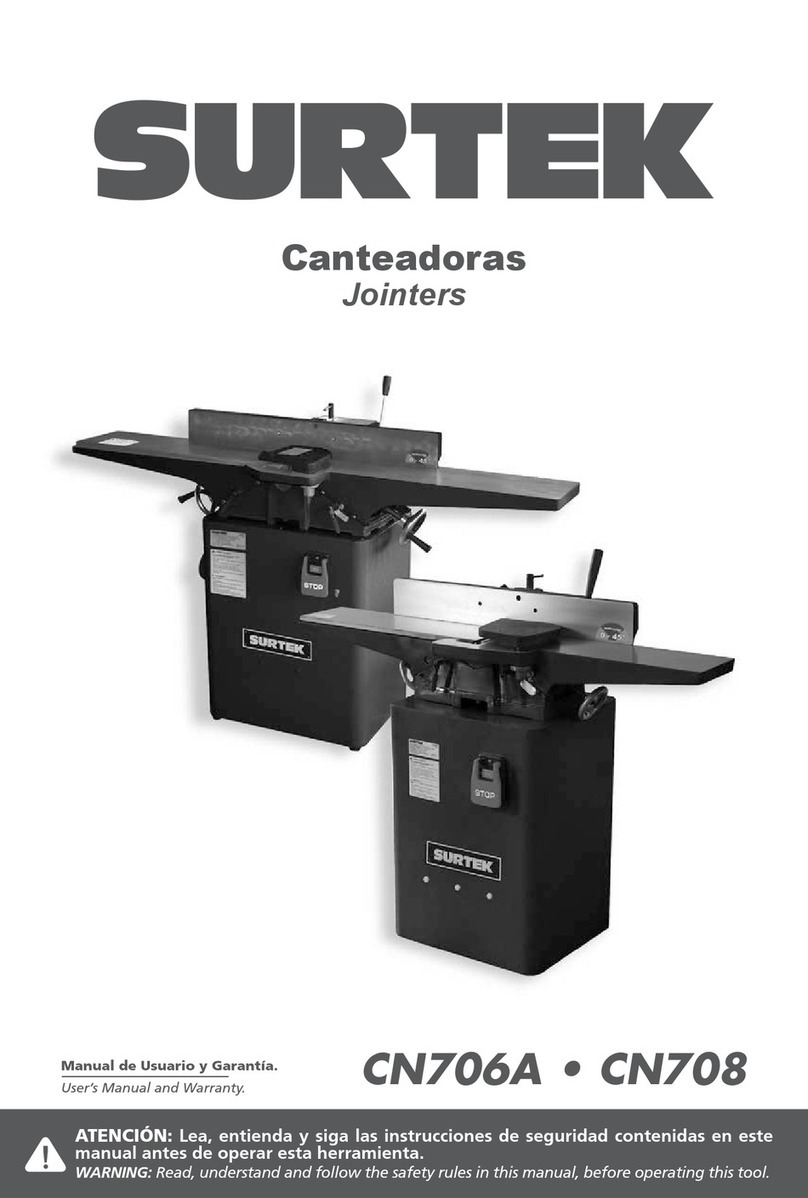
Surtek
Surtek CN708 User manual
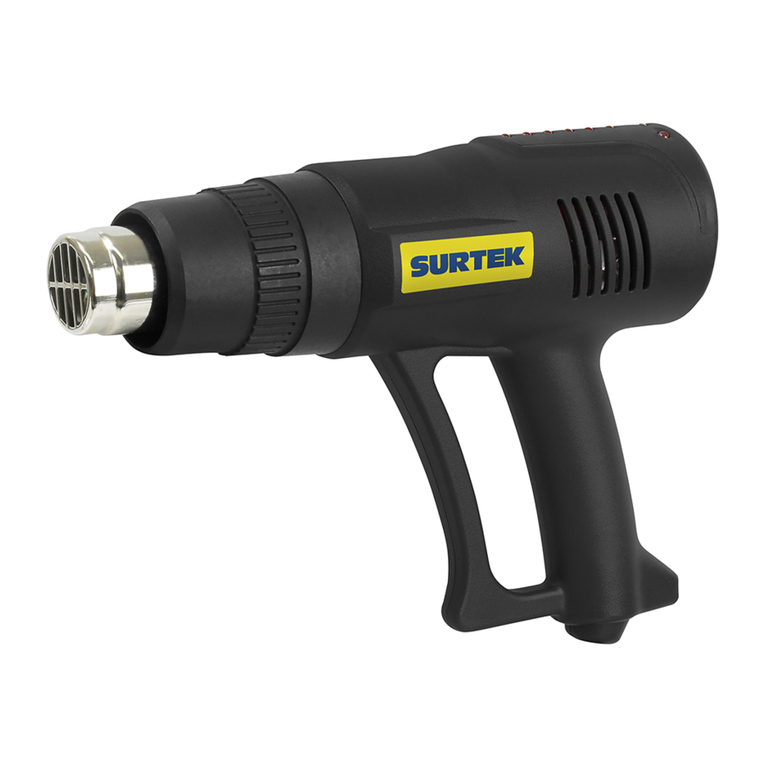
Surtek
Surtek PC600 Dimensions and installation guide
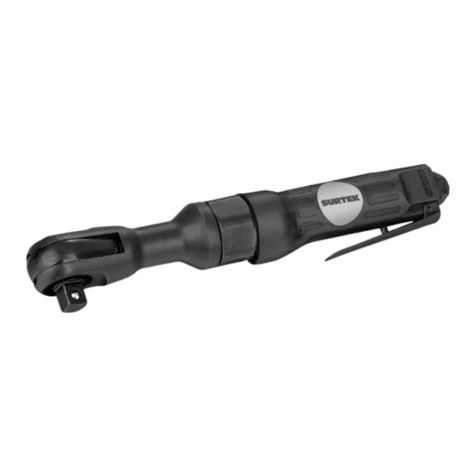
Surtek
Surtek MN638A User manual
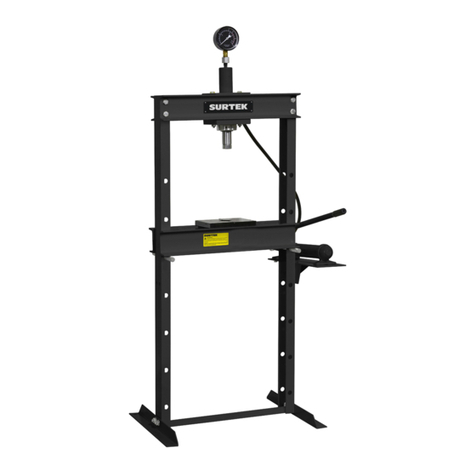
Surtek
Surtek PHIP12 User manual
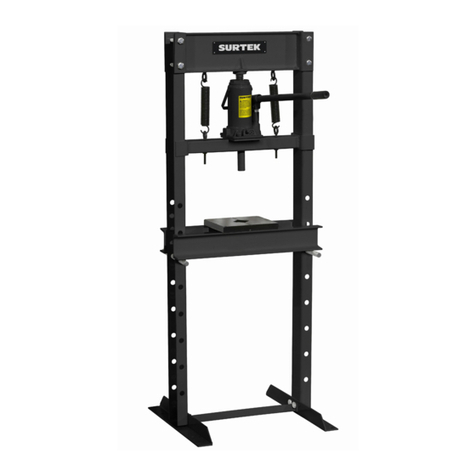
Surtek
Surtek PHI12 Dimensions and installation guide
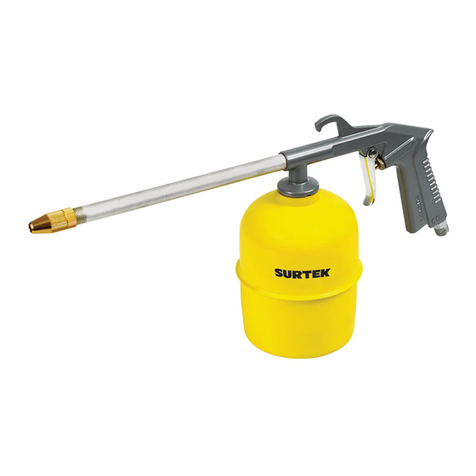
Surtek
Surtek PLM1 Dimensions and installation guide
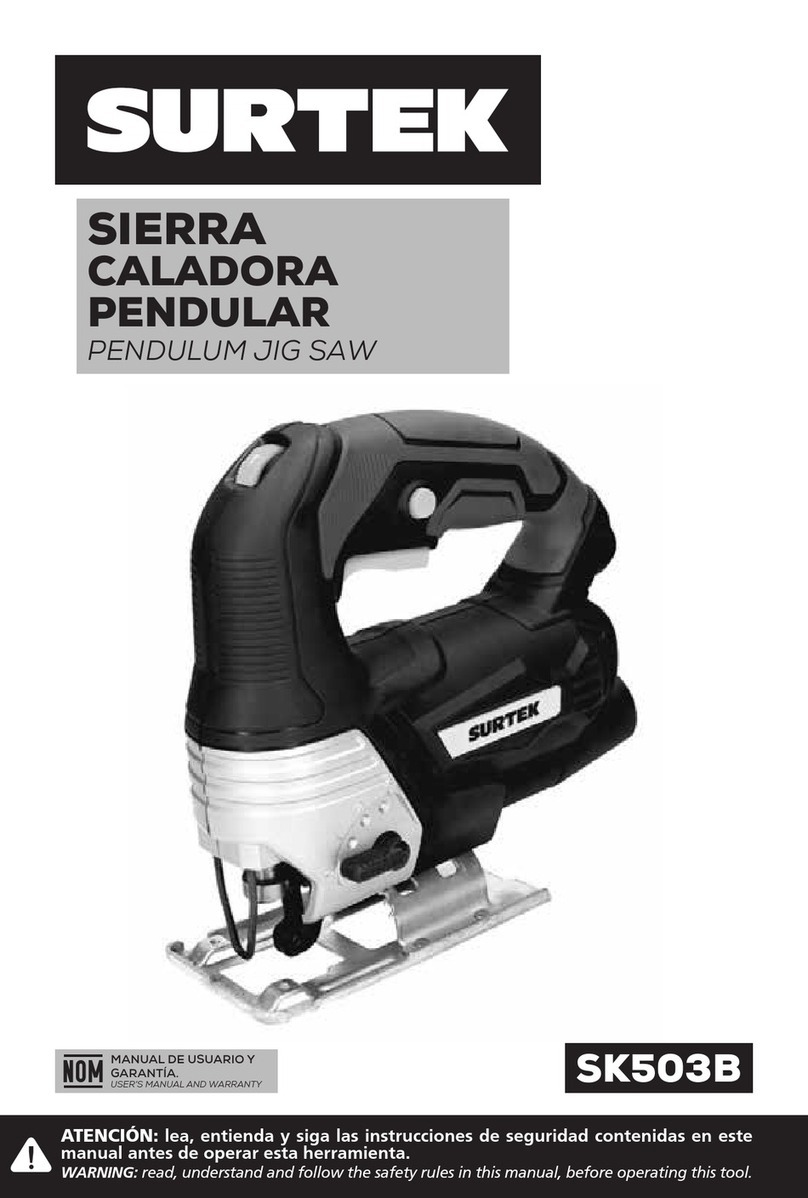
Surtek
Surtek SK503B User manual
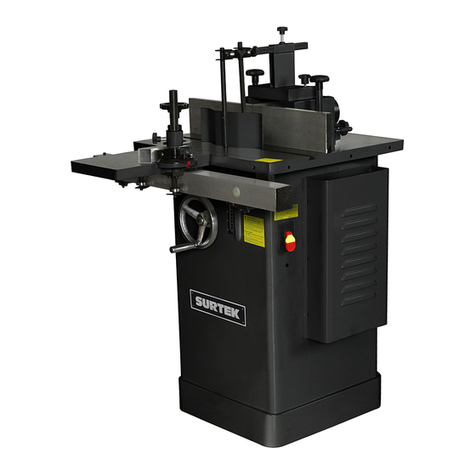
Surtek
Surtek TR702A Dimensions and installation guide
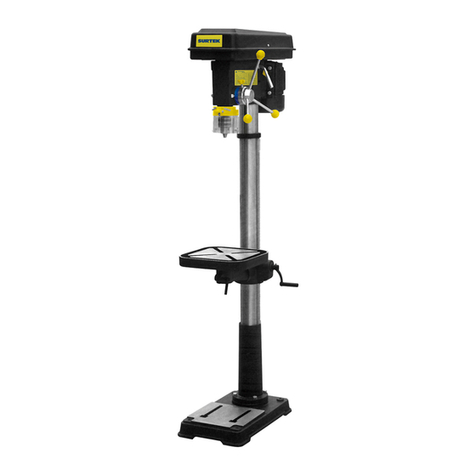
Surtek
Surtek TB572A Dimensions and installation guide
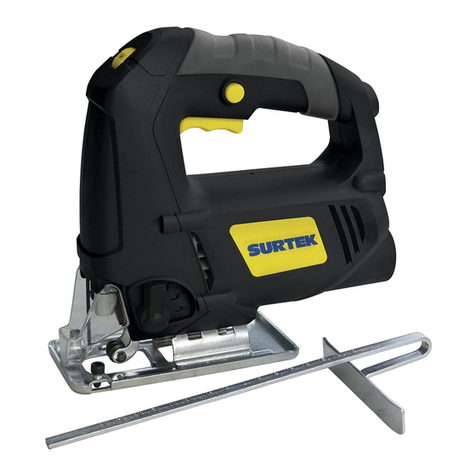
Surtek
Surtek SK503A User manual
